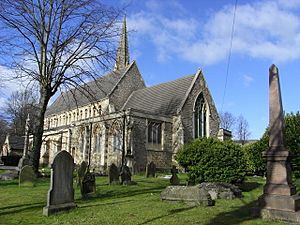St Mark's Church, Swindon facts for kids
Quick facts for kids St Mark's Church, Swindon |
|
|---|---|

St Mark's Church, Swindon, from the south-east
|
|
| Lua error in Module:Location_map at line 420: attempt to index field 'wikibase' (a nil value). | |
| OS grid reference | SU 143 847 |
| Location | Church Place, Swindon, Wiltshire |
| Country | England |
| Denomination | Church of England |
| Churchmanship | Traditional Catholic (Forward in Faith) |
| History | |
| Status | Parish church |
| Dedication | Saint Mark |
| Dedicated | 25 April 1845 |
| Architecture | |
| Functional status | Active |
| Heritage designation | Grade II listed |
| Designated | 2 October 1951 |
| Architect(s) | Scott and Moffatt, Temple Moore |
| Architectural type | Church |
| Style | Gothic Revival |
| Groundbreaking | 1843 |
| Completed | 1897 |
| Specifications | |
| Spire height | 140 feet (43 m) |
| Materials | Limestone, roofed in tiles and lead |
| Administration | |
| Parish | Swindon New Town |
| Deanery | Swindon |
| Archdeaconry | Malmesbury |
| Diocese | Diocese of Bristol |
| Province | Province of Canterbury |
St Mark's Church is an active Anglican church located in the center of Swindon, Wiltshire, England. It is a parish church within the Church of England. The church is part of a group of churches in Swindon New Town. It is also recognized as a Grade II listed building, which means it is an important historic building.
Contents
History of St Mark's Church
St Mark's Church was built to serve the many workers of the Great Western Railway. Their large workshops, known as Swindon Works, were located nearby.
How the Church Was Built
In 1842, George Henry Gibbs, a wealthy banker, left £500 in his will to help build a church and a school in Swindon. In February 1843, the railway company asked the public for donations. They managed to raise a total of £6,000 to build the church.
The church was designed by famous architects George Gilbert Scott and William Bonython Moffatt. Construction took place between 1843 and 1845. The church was officially dedicated to Saint Mark on April 25, 1845, which is St Mark's Day. Later, in 1897, another architect named Temple Moore added a north vestry to the church.
Church Traditions
The church follows the Anglo-Catholic tradition within the Church of England. This means it has certain beliefs and practices that are similar to those of the Catholic Church. For example, the church does not allow women to be ordained as priests or bishops.
Architecture of St Mark's
St Mark's Church is built from limestone. Its roofs are made of tiles and lead. The church's design is in the Decorated Gothic style, which was popular for churches in the past.
Outside the Church
The church has a long main area called a nave. It also has aisles on the north and south sides. There is a south porch, which is an entrance area. The chancel is the part of the church where the altar is located. On the north side, there is a tall spire that reaches about 43 meters (140 feet) high. The spire has decorative elements called crockets and small windows called lucarnes.
The windows along the sides of the church have two lights (sections) and feature beautiful stone patterns called tracery. The large window at the east end of the chancel has three lights.
Inside the Church
Inside, the main arches, called arcades, are supported by quatrefoil piers. These piers have a shape like a four-leaf clover. The nave has a special type of wooden roof called a hammerbeam roof. The chancel roof is shaped like a half-barrel, known as a barrel vault.
The church has beautiful stained glass windows, some of which were made by an artist named Charles Eamer Kempe. The pipe organ was first built in 1922. After being destroyed by a fire in 1973, a new three-manual organ was brought in from another church. St Mark's also has a ring of eight bells. Six of these bells were made in 1904, and the other two were made in 1927.
Musical Tradition
St Mark's Church is known for its strong tradition of choral music. The church choir sings at weekly services and has a large collection of songs. They have even recorded two CDs. In 1944, a famous composer named Benjamin Britten wrote a piece of music called Festival Te Deum for the church's 100th anniversary. It was first performed at St Mark's on April 24, 1945.
Churchyard Memorials
The churchyard around St Mark's contains several interesting memorials and burial sites.
The Gooch Tomb
This monument honors Emma Brent Gooch (who died in 1872) and her husband, William Frederick Gooch (who died in 1915). William was the younger brother of Sir Daniel Gooch, a very important figure in the Great Western Railway. William became the manager of the GWR Works. Although he is buried elsewhere, his name was added to his wife's monument. In 2016, this tomb was rediscovered and cleaned as part of the Swindon 175 celebrations.
Armstrong Monument
This is a polished pink granite obelisk (a tall, four-sided pillar) dedicated to Joseph Armstrong, who died in 1877. Later, the names of his wife, Sarah, and children, George and Joseph, were added, along with John Burdon. Joseph Armstrong was the Superintendent of the GWR Works. His funeral was held at the church on June 9, 1877. On that day, shops in the area closed, special trains were arranged, and a temporary platform was built to handle the large number of people. Over 6,000 mourners attended the service.
Frederick Hawksworth
Frederick William Hawksworth was the last Chief Mechanical Engineer of the Great Western Railway. He passed away in 1976, and his ashes were buried in the churchyard.

